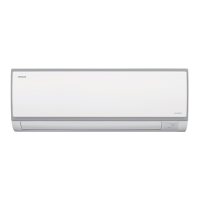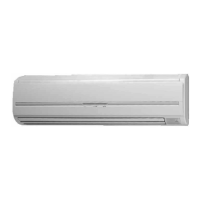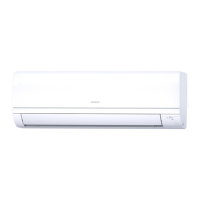
Do you have a question about the Hitachi RPK-0.8FSN3M and is the answer not in the manual?
| Brand | Hitachi |
|---|---|
| Model | RPK-0.8FSN3M |
| Category | Air Conditioner |
| Language | English |
General notes regarding publication reproduction, continuous improvement, and responsibility for errors.
Covers product guide, prior checks, model classification, and combinations of FSXN1E and FSXNH(E) outdoor units.
Details safety symbols, additional safety information, pressure vessel safety, and potential hazards.
Defines the manual's purpose and emphasizes the importance of qualified personnel for installation.
Specifies the operating temperature range for cooling and heating modes for the system.
Describes automatic functions like three-minute protection, frost prevention, defrost cycles, and overload prevention.
Identifies and labels the components of the RAS-8FSXN1E outdoor unit.
Identifies and labels the components of the RAS-(10/12)FSXN1E outdoor unit.
Identifies and labels the components of the RAS-(14/16)FSXN1E outdoor unit.
Identifies and labels the components of the RAS-(5/6)FSXNH(E) outdoor unit.
Identifies and labels the components of the RAS-(8-12)FSXNH(E) outdoor unit.
Diagram and component list for the refrigerant cycle of the RAS-(8-12)FSXN1E outdoor unit.
Diagram and component list for the refrigerant cycle of the RAS-(14/16)FSXN1E outdoor unit.
Diagram and component list for the refrigerant cycle of the RAS-(5/6)FSXNH(E) outdoor unit.
Diagram and component list for the refrigerant cycle of the RAS-(8-12)FSXNH(E) outdoor unit.
Guidelines for securely fastening outdoor units during transport and storage to prevent damage.
Precautions for handling loads with fork-lift trucks to prevent injury and damage to the unit.
Instructions on how to properly lift the unit using hoisting slings through base openings, avoiding damage.
Provides center of gravity data for various outdoor unit models to ensure safe lifting.
Site selection criteria for outdoor units, considering sunlight, ventilation, noise, access, and environmental factors.
Specifies required clearances around the unit for installation, ventilation, and maintenance access.
Details installation requirements for walls in two, three, and four directions, including spacing and ventilation.
Considerations for unit placement, airflow, and grouping, especially in confined spaces or multiple unit installations.
Guidance on foundation requirements, anchorage bolt positions, and ensuring the unit is level and secure.
Covers pipe selection, sizes, connection, insulation, precautions, and detailed diagrams for various system configurations.
Safety measures and concentration limits for refrigerant leaks, especially R410A, to prevent suffocation.
Details on condensation drainage systems, precautions for drainage locations, and the use of optional drainage kits.
General safety precautions for electrical work and verification of power supply, wiring, and components.
Details power supply connection diagrams, cable sizes, main breaker switches, and voltage requirements.
Instructions for connecting power and communication cables for outdoor and indoor units, including wiring diagrams.
Details on setting DIP switches for refrigerant cycle, unit number, capacity, and test run/service functions.
Essential checks before performing the test run, including refrigerant pipes, cables, and unit settings.
Procedure for conducting the test run for indoor units, checking system conformity, and operating components.
Instructions for using the PC-ART remote controller to perform the test run, including setting and checking operations.
Steps for initiating and conducting a test run using the PC-ARF remote controller, including checks and abnormal sound detection.
A checklist for verifying critical parameters during the test run, covering fan rotation, compressor, temperatures, pressures, and voltages.
A comprehensive list of common alarm codes, their categories, content of abnormality, and possible causes.












